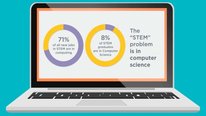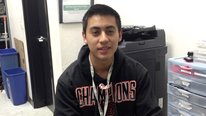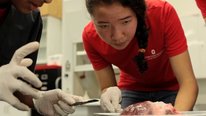
SARAH PIDGEON
Choice
GreenTECH
NSF Awards: 1139308
Solar One’s CleanTech uses the school building as a teaching tool to explore sustainability and green careers with high school students. CleanTech is hands-on and project-based. The program engages students in inquiry-based learning and inspires them to take action through school greening initiatives that make an impact through saving energy, recycling, water conservation, and more.
GreenTECH
NSF Awards: 1139308
Solar One’s CleanTech uses the school building as a teaching tool to explore sustainability and green careers with high school students. CleanTech is hands-on and project-based. The program engages students in inquiry-based learning and inspires them to take action through school greening initiatives that make an impact through saving energy, recycling, water conservation, and more.
-
 Acquainting Metro Atlanta Youth With STEM (AMAYS)
Acquainting Metro Atlanta Youth With STEM (AMAYS)
Brendan Calandra
-
 Innovation Institute at the New York Hall of Science
Innovation Institute at the New York Hall of Science
Priya Mohabir
-
 SPARCS - Sparking student interest in computing careers
SPARCS - Sparking student interest in computing careers
Harvey Siy
-
 Lens on Climate Change
Lens on Climate Change
Anne Gold
-
 #NESTworking: Advancing Tech Careers and Entrepreneurship
#NESTworking: Advancing Tech Careers and Entrepreneurship
Jill Denner
-
 Expanding STEM Opportunities through an Inclusive STEM HS
Expanding STEM Opportunities through an Inclusive STEM HS
Sharon Lynch
6500 Views
Continue the discussion of this presentation on the Multiplex. Go to Multiplex
6500 Views
Related videos you might be interested in...
-
 Acquainting Metro Atlanta Youth With STEM (AMAYS)
Acquainting Metro Atlanta Youth With STEM (AMAYS)
Brendan Calandra
-
 Innovation Institute at the New York Hall of Science
Innovation Institute at the New York Hall of Science
Priya Mohabir
-
 SPARCS - Sparking student interest in computing careers
SPARCS - Sparking student interest in computing careers
Harvey Siy
-
 Lens on Climate Change
Lens on Climate Change
Anne Gold
-
 #NESTworking: Advancing Tech Careers and Entrepreneurship
#NESTworking: Advancing Tech Careers and Entrepreneurship
Jill Denner
-
 Expanding STEM Opportunities through an Inclusive STEM HS
Expanding STEM Opportunities through an Inclusive STEM HS
Sharon Lynch
Joni Falk
I really love this presentation. Can you tell me more as to how the Solar One activities get integrated into different subjects? Is it integrated into science? or math? Are the activities school wide? Who develops them? How many classes during the year are devoted to it?
Do the teachers receive professional development? How much PD do they get? I would love to hear more details. Thanks again for a very interesting video!
Sarah Pidgeon
Solar One Educators developed CleanTech with the support of a steering committee and an advisory council representing folks from the green industry, and classroom teachers.
We primarily work with science teachers, but we have also worked with math, art, ELA, engineering teachers, and more! We always push for schools to make the program interdisciplinary. For example, in one activity students work on sizing a solar PV system for a school rooftop which works really well in a math class. Or, after students conduct an energy audit, they might work on an energy awareness campaign with their ELA or art teacher.
We provide professional development training for teachers, and we also deliver some of the hands on activities side-by-side with teachers in the classroom.
Most of our partner teachers participate in anywhere from 6-18 hours of training. Thanks again!
Gillian Puttick
Wonderful to see so many engaged students! Can you tell me a little about your dissemination strategies? Impressive that you’ve expanded from 4 to over 160 schools.
Sarah Pidgeon
Thank you Gillian!We ran the pilot with 4 schools over the course of two years, and since that we have delivered a mix of professional development training (6-18 hours per teacher) and co-teaching workshops to reach teachers at over 160 schools. We are excited to continue to learn how teachers are using the curriculum after a co-teaching workshop or a professional development training program. Thanks!
Gillian Puttick
Thanks Sarah. I’m particularly interested in the methods you used to recruit the teachers – was it by word of mouth? Social media? Presentations at schools?
Sarah Pidgeon
Hey there,
We partner with the NYC Department of Education, and they have really supported us through helping to get the word out. In some cases we delivered 3 day workshops as part of a larger citywide STEM training event. We also host free PD training on the 2 citywide staff development days for teachers, and those have been well attended. We also have a monthly newsletter, and have presented at several conferences. I would say that our partnership with DOE has really been the most helpful in recruiting teachers. We have also worked to provide teachers with materials tool kits which helps as an incentive. Thanks!
Sarah Gerard
Education Researcher
Fantastic presentation – I loved seeing students in so many different environments engaging in hands-on STEM exploration! Given that research continues to demonstrate the importance of early science learning experiences – before high school – are there any plans to expand the program into elementary and/or middle schools? I’m thinking of the research of Maltese and Tai in particular, and their 2010 paper finding that 70% of scientists and 69% of science graduate students reported developing their interest in science before high school.
Sarah Pidgeon
Thank you! You brought up an excellent point. We actually did the reverse for this program- we started with a program called The Green Design Lab for 3rd-5th grade students and 6th-8th grade students. With support from NSF, we took the core ideas from our 3rd-8th curricular guides and used them to design our more advanced high school program- CleanTech!
Kelly Pudelek
Survey Specialist
CleanTech sounds like a great program to help students really engage in science. I especially like how the school building is used as a teaching tool. How do you plan to evaluate the program?
Sarah Pidgeon
Thank you Kelly! We are at the tail end of our pilot program and worked with an outside evaluator. We conducted surveys with our partner teachers, did a pre-post knowledge and attitude survey with students, and ran some student focus groups. We are hoping to be able to share the data from the evaluation soon!
Nancy Romance
I like your program because it encompasses the engineering elements partnered with the science elements. First-hands experience with design and problem solving are valuable for students to learn and retain science concepts.
Sarah Pidgeon
Thank you Nancy! That was a major part of our design process. While partnering with our 4 partner schools for the pilot, we actually worked with science teachers, engineering teachers, architecture teachers, and electrical teachers. It was great to combine science and career and technical education!
Marian Pasquale
Senior Research Scientist
What an excellent video and program. I particularly like the focus on real world problems. The video mentions that Clean Tech engages students with real world situations about energy, water,food and materials. I’s like to hear about the kinds of activities you engage students in about food.
Sarah Pidgeon
Thank you Marian! For our food unit we explore topics including food systems, industrial agriculture, processed food and nutrition, population and food production, and soil science. Students conduct community food surveys, build DIY classroom hydroponic systems, and conduct carrying capacity labs to explore exponential growth. One of my favorite lessons focuses on the history of school food, it is so interesting to look back!
Marian Pasquale
Senior Research Scientist
Sarah, how interesting! I’m sure the students really dig into these activities. These are just the kinds of topics and activities that develop students’ understanding and engagement.
Leora Falk
This is so interesting. I work on election access in the developing world, and we talk a lot about how STEM education can focus more on clean energy. Do you think there could be applications of this program outside of urban environments, or in urban but developing environments? There might be a great opportunity in places where the students could even have a say in the building of a new school!
Further posting is closed as the showcase has ended.